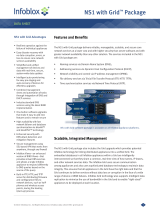
8 | Identifying Hardware Requirements Dell Networking W-AirWave 8.0 | Server Sizing Guide
AppRF can produce a lot of data and increase the AirWave’s storage requirements, but an upper bound can be
configured to mitigate that problem.
l SNMP Poll Periods: The AW-HW-ENT appliance is certified with default polling periods (i.e., 10 minutes for
interface polling, 5 minutes for up/down polling). More aggressive or frequent AirWave polling needs a server with
increased CPU and IOPS capacity to handle the increased workload.
l RAPIDS. The Rogue AP Intrusion Detection System (RAPIDS) is another feature that can have a major impact the
AirWave server size. Identifying and processing rogue APs consumes CPU and disk resources on the AMP. If the
AirWave manages an AP that detects many APs in other networks (for example, if your AP is in an open plaza or an
atrium in a shopping mall) then that AP will likely identify a large amount of rogue APs, requiring increased server
capacity.
l VisualRF: The numbers of floor plans and campuses managed and monitored by AirWave directly impacts the
amount of memory used by the VisualRF feature. The AirWave server may need more memory resources to manage a
complex network using VisualRF.
l Data Retention Periods. Long retention periods increase the bulk of data the AirWave has to manage. If your
network requires longer data retention periods than the default retention settings, consider a server with a larger disk
capacity than the tested devices.
l Reports. The type, frequency and scope of reports can have an large impact on the AirWave. The AirWave RAID
controllers are configured for write-back, so they behave like an solid-state drive for writes. Reads, on the other hand,
take much more processing resources. Report generation require that a lot of data is read from the disk, which slows
the disk subsystem. Internal testing is focused on the steady-state of the AirWave, and does not explicitly factor in
report generation and processes like nightly maintenance. Internal testing ensures the steady-state never uses 100% of
the server's resources so there is extra processing available when needed. If you will be generating reports frequently,
consider a server with a greater IOPS and disk capacity.
l Instant APs: The Supported Devices values in Table 1do not apply to Instant APs unless the following criteria are
met.
n Device counts are adjusted for virtual controllers
A Instant AP acting as a virtual controller is managed as two devices; one virtual controller, and one AP. (This is
in contrast to Instant APs associated to the Instant virtual controller and standard APs, which are counted as a
single device). If your network includes a large number of standalone Instant APs acting as virtual controllers, be
aware that this may impact the device count. The Supported Devices values in in Table 1 assume that these
devices are standard APs. If your network includes many Instant virtual controllers, your hardware requirements
must take into consideration increased device count.
n WANLink is High Quality.
The quality of the WAN link has a large impact on Instant networks. Poor WAN link quality increases the
amount of time it takes for an Instant AP to download new firmware, causing downloads to take longer. This
increases http socket utilization, reducing the ability of other Instant APs to initiate their firmware downloads.
Configuration updates are pushed from AirWave to Instant APs one device at a time, so if an Instant AP on poor
quality WAN link is slow to update, that AP acts as a bottleneck, slowing down the configuration push to other
devices.
n Rogue Polling and VisualRF are disabled
A single Instant AP cannot accurately detect rogue APs or determine VisualRF location information, as these
features typically require triangulation between three or more APs to accurately detect the locations of other
devices on the networks. Best practices are to disable rogue polling and VisualRF in networks with just a single
Instant AP per location, to reserve memory and CPU utilization resources for other processes.













